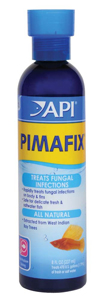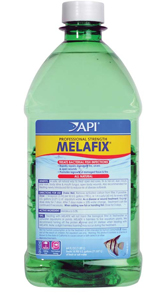Cupramine 50ml
$7.34
Free shipping for all orders over $50*
Details
Download PDFsCupramine is a truly different and better copper formulation that safely and effectively eradicates ectoparasites of both freshwater and marine fish. This copper is both buffered and amine-complexed. It is a little more expensive than some other copper products but well worth the premium.
Cupramine is superior to copper sulfate, chloride & citrate: it is non-acidic, less toxic to fish, remains in solution, and does not contaminate the filter bed. It is superior to chelates: it is fully charged (ionic), and active at low concentrations, and is removable with carbon.
DIRECTIONS: Remove all invertebrates. Turn off UV sterilizer; remove chemical filtration. Use 1 mL (top mark of enclosed dispenser) per 40 L (10.5 gallons*) the first day, wait 48 hours, then repeat for a total dose of 0.5 mg/L (in freshwater, use half dose). Leave at this concentration for 14 days. Do not redose without testing Copper. Do not use in conjunction with any other medication. If tank has ever been treated with an ionic copper (e.g. copper chloride, sulfate or citrate), test copper level after initial dosing. Although most fish tolerate Cupramine up to 0.8 mg/L, it is not advisable to exceed 0.6 mg/L copper. Remove with carbon or CupriSorb.
FAQ from Seachem
Q: How often do I need to treat with Cupramine?
A: Unlike ionic copper or copper citrates, Cupramine will not precipitate out. Once a level is attained it will remain there until removed by carbon, CupriSorb, or other material. You may see a lower than expected level if you have crushed coral substrate or live rock. It is recommended that you quarantine fish in hospital tanks before entering them into your display system and when treating with any medication. As with any copper medication, it is not safe for use in a reef tank.
Q: I’ve been dosing with Cupramine, and then I added Product X and everything died. What happened?
A: If Product X is a reducing agent such as ParaGuard (or other aldehyde based medications) or if you overdose with a dechlorinator, such as Prime, then the Cu+2 will be reduced to Cu+. Cu+ is 10 times more toxic than Cu+2.
Q: I’ve just started using Cupramine, although I had been using an ionic copper (copper sulfate) product several months ago. I find that when I dose as prescribed with the Cupramine, I’m getting a higher level of copper than I should be. Why?
A: The ionic copper has been adsorbed onto your filter bed and is now being extracted and solubilized by the amine complex in Cupramine. You can either adjust your Cupramine dose accordingly, use our CupriSorb to slowly extract the copper from the filter bed (although this could take weeks depending on how much copper is adsorbed), or replace the filter bed.
Q: I’m using Cupramine and my ammonia test kit is showing ammonia off the scale. What is going on?
A: Ammonia test kits can not distinguish ammonia from the amine based complex present in Cupramine and will therefore give a false high reading for ammonia while using Cupramine. Our Ammonia Alert and MultiTest: Free & Total Ammonia test kit do not suffer from this problem as they utilize a gas exchange technology that can distinguish ammonia from amines.Q: Is Cupramine safe to use with sharks and rays?
A: Yes, but use carefully-perhaps start with a 1/4 dose and increase slowly as indicated by no signs of any adverse reaction.
Q: Can you tell me if Cupramine is effective against gill fluke?
A: Yes, Cupramine effectively eradicates ectoparasites of both freshwater and marine fish. Please be sure to follow all directions on the product, make sure that you do not mix with any other medications, and turn off your UV sterilizer. Please let me know if you have any further questions.
Q: Will the Cupramine kill nitrifying bacteria in the filter? I used it to treat the parasite problem in a 20g quarantine tank. Three days later, I tested the ammonia level, and it was about 0.5 ppm. The copper level was about 0.25 ppm, and the nitrite level was about 0ppm.
A: Cupramine may slightly retard the bacteria but overall it is safe to use and won’t adversely affect the nitrifying bacteria. The reading of ammonia you’re getting is most likely a false reading because Cupramine contains an organic amine which is very similar to ammonia in structure and the test kit is likely not able to distinguish between the two. You can use our Ammonia Alert which works on the same principal and will show only free ammonia.
Q: The Cupramine on line instruction says dose of 0.5 ppm but the bottle instruction says .5 mg/l. Is there any difference between ppm and mg/l? I could not find Sea Chem test kit so I bought Red Sea test kit which is non-chelated base and in ppm units. Is it OK?
A: The use of the Red Sea kit should be fine. The recommended dose of Cupramine will get you to .5 mg/l.
The relation between ppm and mg/l is the same: they equal 1 : 1.
Q: Does using Cupramine in saltwater affect the results of other test kits e.g. alkalinity and pH ?
A: Cupramine will not affect the previously mentioned tests as this product is buffered and will not negatively influence pH or alkalinity.
Q: What’s the shelf life of your Cupramine product?
A: Cupramine, like the rest of our line, is designed to have an indefinite shelf life (relatively speaking). The only way this product may not function properly is if something was purposely added to the bottle to contaminate the product or precipitate the ingredients out of solution.
Q: I am treating my 90 Gallon tank with Cupramine. I’ve removed the activated charcoal and carbon, and I turned off the UV and the Ozonizer. Should I turn off my Protein Skimmer?
A: It is perfectly acceptable and recommended to leave your skimmer on during treatment.
Q: I have added Cupramine to my reef tank. I pulled all of my corals out and treated it once. I was told that if I added copper to my tank that I wouldn’t be able to put my corals back in and that the copper would contaminate my filter bed and stick to the silicone seams. Is that correct and how should I remove the Cupramine from my tank? And should I treat it a second time?
A: Our Cupramine is the only copper based remedy of it’s kind on the market as this technology is very unique to our company. This copper based remedy is complexed to an organic (amine), hence the name Cupramine. This complex is very stable in water, meaning it is the least likely of all the copper remedies to stick to a gravel bed or live rock. I am not aware of any copper that sticks to silicon seals. It is also very easy to remove with carbon as this copper remedy is complexed to an organic, and carbon readily removes organic material. We also manufacture Cuprisorb for copper removal. This product is very aggressive at removing copper based remedies (as well as other heavy metals). This resin will change colors as it removes copper and is regenerable. Continue to regenerate and use this product until you do not see the resin change color for a week. By then, most/all of the copper should be removed from your system. You can make sure of this by testing with our MultiTest Copper test kit.
Considering that you have already added Cupramine to your reef aquarium, I would definitely follow the instructions (2 doses 2 days apart). The instructions are based on gallons (1 ml per 10 gallons). Be sure to estimate the correct amount of gallons in your aquarium for proper dosing. If your aquarium is a typical reef with a lot of rock, you have displaced some of the gallons of your aquarium. Given that you have dosed your aquarium once with Cupramine, I would test the level of copper to figure out what level you currently have. Ex., If you have dosed 3 ml and come out with .25 ppm of copper, you know dosing another 3 ml will raise the level another .25 ppm for a total of .50 ppm, which is the recommended concentration for this product. Keep in mind that this product is still effective as low as .20 ppm and generally safe for fish up to .80 ppm, but we recommend .50 ppm as the ideal level.
You can also use GarlicGuard in the food to help enhance the immune system of the fish. If the fish have trouble eating, this product will also act as an appetite stimulant. GarlicGuard can be used in conjunction with Cupramine.
Q: Is there is any problem with using Formalin in concentration of 25mg/l with Cupramine ?
A: YES! Do not use Formalin with Cupramine or any other copper medication. It will reduce the Copper +2 to Copper +1 which is highly toxic at even small doses.
Read More









Reviews
There are no reviews yet.